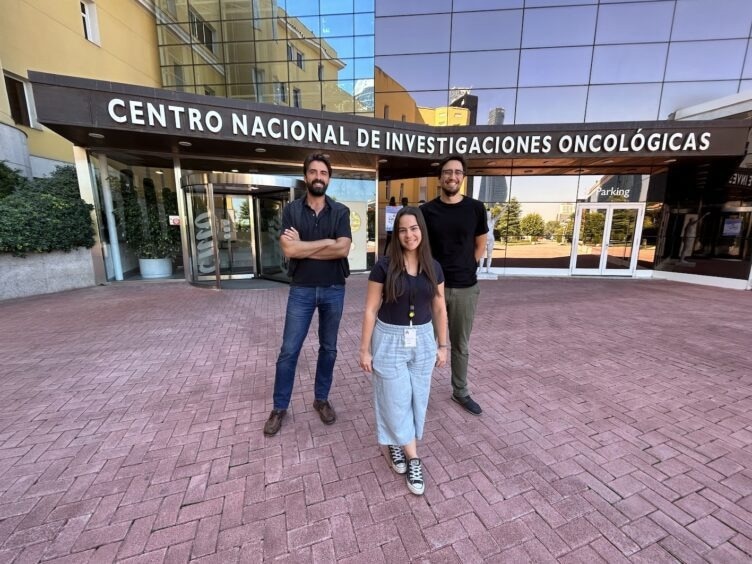Reviewed by Danielle Ellis, B.Sc.Nov 1 2023
In the late 1970s, the link between the c-Src gene and cancer was unveiled, marking the identification of the inaugural oncogene.
 From left to right: Iván Plaza-Menacho, senior author, and first authors Julia Contreras and Hipólito Nicolás Cuesta Hernández. Image Credit: Esther Sánchez/CNIO.
From left to right: Iván Plaza-Menacho, senior author, and first authors Julia Contreras and Hipólito Nicolás Cuesta Hernández. Image Credit: Esther Sánchez/CNIO.
Since that time, it has been observed that c-Src experiences overactivation in approximately half of colon, liver, lung, breast, prostate, and pancreatic tumors. However, its precise role remains elusive.
Recently, researchers at the Spanish National Cancer Research Center (CNIO) have unearthed a novel molecular mechanism, previously undocumented, that enables this oncogene to activate itself. This discovery carries significant implications for the development of novel pharmaceuticals.
Over the past few decades, targeted therapies have emerged, introducing the first medications tailored to combat specific molecular culprits underlying cancer, thereby enhancing their effectiveness and minimizing side effects.
Many of these medications work by inhibiting the action of a group of enzymes known as tyrosine kinases, ushering in substantial progress in the targeted treatment of various cancer types.
Thus, the significance of the breakthrough made by the team led by researcher Iván Plaza-Menacho at CNIO becomes evident: the revelation of a fresh activation mechanism for the initial recognized tyrosine kinase, which also happens to be the pioneering oncogene.
We have found a new paradigm in the mechanism of action of the first identified oncogene, c-Src, with important implications for the discovery of next-generation drugs.”
Plaza-Menacho, Head, Protein Phosphorylation and Cancer Group, Spanish National Cancer Research Center
The study has been published in the journal Nature Communications.
An Oncogene Overactivated in the Most Prevalent Tumors
Kinases play a pivotal role in chemical modifications of other proteins, introducing phosphate groups to them.
This process of phosphorylation serves as a chemical signal that triggers cell proliferation. When kinases malfunction, cells continually receive the directive to proliferate, ultimately leading to the formation of tumors.
While the connection between c-Src and cancer was initially unearthed at the molecular level in the late 1970s, it remains a subject of ongoing research, as the understanding of this relationship is not yet complete, even after many years.
In roughly 50% of colon, liver, lung, breast, prostate, and pancreatic tumors, the c-Src oncogene exhibits a state of overactivation.
What the new research uncovers is a previously unforeseen mechanism by which c-Src can autonomously activate itself through autophosphorylation, a process in which the protein phosphorylates itself, ultimately instigating the development of cancer.
An Autophosphorylating Oncoprotein
Until now, it was established that the role and operational status of the c-Src oncogene are regulated by another protein kinase called CSK. CSK phosphorylates a critical tyrosine residue in c-Src, leading to the inhibition of its function.
However, CNIO scientists have currently displayed that c-Src, besides, “has the ability to autonomously regulate the phosphorylation of this key tyrosine by phosphorylating itself,” says Iván Plaza.
The authors have successfully unraveled the autophosphorylation sequence and the assembly procedure of the active molecule, which serves as a kinase, in conjunction with the molecule that undergoes phosphorylation, functioning as a substrate, at a high-resolution level.
A Therapeutic Target in Different Types of Cancer
Inhibitors designed to target c-Src activity have proven to be valuable in therapeutic contexts. One such example is dasatinib, which has received approval for treating patients afflicted with conditions like multiple myeloid leukemia and acute lymphocytic leukemia.
Presently, clinical trials are underway involving patients suffering from metastatic breast cancer, colon cancer, and prostate cancer.
These trials are evaluating the effectiveness of inhibitors that not only target c-Src activity but also interact with other kinases. Examples of such inhibitors include bosutinib, bafetinib, and saracatinib.
The new outcomes obtained by the CNIO group, “have important implications in the design of and search for new generation drugs that block the allosteric and non-catalytic function of c-Src as a substrate in a more specific way,” states Iván Plaza-Menacho.
The scientist advances that “in the future we want to determine the three-dimensional structure of c-Src in its complete format, and to know how it is assembled and with which molecules it is capable of interacting and regulating at the cellular level when it is hyperphosphorylated in cancer.”
Source:
Journal reference:
Cuesta-Hernández, H. N., et al. (2023) An allosteric switch between the activation loop and a c-terminal palindromic phospho-motif controls c-Src function. Nature Communications. doi.org/10.1038/s41467-023-41890-7